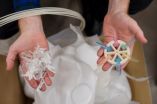(Press-News.org) With one in seven humans undernourished, and with the challenges of population growth and climate change, the need for efficient food production has never been greater. Eight strategies to cut the environmental and economic costs of keeping livestock, such as cows, goats and sheep, while boosting the quantity and quality of the food produced have been outlined by an international team of scientists.
The strategies to make ruminant - cud-chewing - livestock a more sustainable part of the food supply, led by academics at the University of Bristol's School of Veterinary Sciences, are outlined in a Comment piece in Nature this week.
The eight strategies include:
Feed animals less human food.
Livestock consume an estimated one-third or more of the world's cereal grain, which some advocate would be better used to feed people directly. Some of this could indeed be avoided by capitalising on ruminants' ability to digest food that humans cannot eat, such as hay, silage and high-fibre crop residues.
Raise regionally appropriate animals.
Working to boost yields from local breeds makes more sense in the long term than importing poorly adapted breeds that are successful elsewhere. European and North American Holstein dairy cows can produce 30 litres of milk a day. Thousands of these animals have been exported to Asia and Africa in an attempt to alleviate malnutrition. But exposed to hot climates, tropical diseases and sub-optimal housing, the cows produce much less milk, and the costs of feed and husbandry far exceed those of native breeds. Farmers, therefore, should be encouraged to keep and improve livestock adapted to local conditions.
Keep animals healthy.
Human and livestock disease are generally treated as separate problems, but sick animals can make people sick. In low- and middle-income nations, 13 livestock-related zoonoses (diseases transferable between animals and humans) cause 2.4 billion cases of human illness and 2.2 million deaths each year. Animal management should include measures to control transmissible diseases, by improving hygiene, quarantining new arrivals on farms and establishing co-ordinated, sustained surveillance for diseases that cross the boundaries of species or countries.
Adopt smart supplements.
Supplements can boost the productivity of ruminant animals by encouraging microbes in the rumen to grow quickly and provide the animals with better nutrition. Also, with some supplements, animals can produce more milk and meat for proportionally less greenhouse gas.
Eat quality not quantity.
Raising animals for milk and meat is often considered at odds with the challenge of feeding a growing human population, but for undernourished communities there are health benefits to consuming healthy animal products. However, the goal of public health should be a balanced diet across all countries, with a target of no more than 300 grams of red meat per person per week.
Tailor practices to local culture.
Close to one billion of the world's poorest people rely on livestock for their livelihood. Traditional animal husbandry supplies more than just food. Keeping animals provides wealth, status and even dowry payments. However, the benefits of keeping animals are disrupted when conventional grazing and mixed-farming practices are replaced with industrial systems that prioritise short-term production. Policies to encourage high welfare, efficient management should consider cultural as well as natural factors.
Track costs and benefits.
Despite ruminant livestock's poor image as major greenhouse gas emitters, sustainably managed grazing can increase biodiversity, maintain ecosystem services and improve carbon capture by plants and soil. A cow produces up to 70 kg of manure per day, providing enough fertilizer in a year for one hectare of wheat, equivalent to 128 kg of synthetic nitrogen that might otherwise come from fossil fuels.
Study best practice.
A global network of research farms — known as farm platforms — can evaluate the economic and environmental benefits of these and other farming practices, act as examples for local farmers to follow and provide valuable information for policymakers.
Professor Mark Eisler, Chair in Global Farm Animal Health in the School of Veterinary Sciences and Cabot Institute at the University of Bristol, said: "The quest for 'intensification' in livestock farming has thundered ahead with little regard for sustainability and overall efficiency, the net amount of food produced in relation to inputs such as land and water.
"With animal protein set to remain part of the food supply, we must pursue sustainable intensification and figure out how to keep livestock in ways that work best for individuals, communities and the planet."
INFORMATION:
Paper: Steps to sustainable livestock: With improved breeding and cultivation, animals can yield food that is better for people and the planet. Mark C. Eisler, Michael R. F. Lee, John F. Tarlton and Graeme B. Martin.
With John Beddington, Jennifer A. J. Dungait, Henry Greathead, Jianxin Liu, Stephen Mathew, Helen Miller, Tom Misselbrook, Phil Murray, Valil K. Vinod, Robert Van Saun and Michael Winter, Nature, Vol 507, 6 March 2014.
Livestock can produce food that is better for the people and the planet
2014-03-05
ELSE PRESS RELEASES FROM THIS DATE:
ALS-linked gene causes disease by changing genetic material's shape
2014-03-05
Johns Hopkins researchers say they have found one way that a recently discovered genetic mutation might cause two nasty nervous system diseases. While the affected gene may build up toxic RNA and not make enough protein, the researchers report, the root of the problem seems to be snarls of defective genetic material created at the mutation site.
The research team, led by Jiou Wang, Ph.D., an assistant professor of biochemistry and molecular biology and neuroscience at the Johns Hopkins University School of Medicine, reports its finding March 5 on the journal Nature's ...
Study aims to define risk factors for falls in post-menopausal women
2014-03-05
ROSEMONT, Ill.–A new study appearing in the March issue of the Journal of Bone and Joint Surgery (JBJS) showed that women with distal radius (wrist) fractures had decreased strength compared to similar patients without fractures. This could explain why these women were more likely to fall and might sustain future fractures.
The investigators used a variety of balance and strength tests combined with patient-provided information about walking habits to evaluate the physical performance and risk of falls for post-menopausal women with and without previous wrist fractures. ...
UF researchers find drug therapy that could eventually reverse memory decline in seniors
2014-03-05
GAINESVILLE, Fla. — It may seem normal: As we age, we misplace car keys, or can't remember a name we just learned or a meal we just ordered. But University of Florida researchers say memory trouble doesn't have to be inevitable, and they've found a drug therapy that could potentially reverse this type of memory decline.
The drug can't yet be used in humans, but the researchers are pursuing compounds that could someday help the population of aging adults who don't have Alzheimer's or other dementias but still have trouble remembering day-to-day items. Their findings will ...
NASA sees Tropical Cyclone Faxai stretching out
2014-03-05
When a tropical cyclone becomes elongated it is a sign the storm is weakening. Imagery from NASA-NOAA's Suomi NPP satellite today revealed that wind shear was stretching out Tropical Cyclone Faxai and the storm was waning.
On March 5 at 1500 UTC/10 a.m. EST, Tropical Cyclone Faxai's center was located near 22.5 south and 155.2 east, about 699 nautical miles/804.4 miles/ 1,295 km west-northwest of Wake Island. According to the Joint Typhoon Warning Center or JTWC, Faxai's maximum sustained surface winds dropped to 50 knots/57.5 mph/92.6 kph. Faxai was moving to the northeast ...
UCSB study explores cocaine and the pleasure principle
2014-03-05
(Santa Barbara, Calif.) — On the other side of the cocaine high is the cocaine crash, and understanding how one follows the other can provide insight into the physiological effects of drug abuse. For decades, brain research has focused on the pleasurable effects of cocaine largely by studying the dopamine pathway. But this approach has left many questions unanswered.
So the Behavioral Pharmacology Laboratory (BPL) at UC Santa Barbara decided to take a different approach by examining the motivational systems that induce an animal to seek cocaine in the first place. Their ...
First-ever 3D image created of the structure beneath Sierra Negra volcano
2014-03-05
The Galápagos Islands are home to some of the most active volcanoes in the world, with more than 50 eruptions in the last 200 years. Yet until recently, scientists knew far more about the history of finches, tortoises, and iguanas than of the volcanoes on which these unusual fauna had evolved.
Now research out of the University of Rochester is providing a better picture of the subterranean plumbing system that feeds the Galápagos volcanoes, as well as a major difference with another Pacific Island chain—the Hawaiian Islands. The findings have been published in the Journal ...
Brain circuits multitask to detect, discriminate the outside world
2014-03-05
Imagine driving on a dark road. In the distance you see a single light. As the light approaches it splits into two headlights. That's a car, not a motorcycle, your brain tells you.
A new study found that neural circuits in the brain rapidly multitask between detecting and discriminating sensory input, such as headlights in the distance. That's different from how electronic circuits work, where one circuit performs a very specific task. The brain, the study found, is wired in way that allows a single pathway to perform multiple tasks.
"We showed that circuits in the ...
Similarity breeds proximity in memory, NYU researchers find
2014-03-05
Researchers at New York University have identified the nature of brain activity that allows us to bridge time in our memories. Their findings, which appear in the latest issue of the journal Neuron, offer new insights into the temporal nature of how we store our recollections and may offer a pathway for addressing memory-related afflictions.
"Our memories are known to be 'altered' versions of reality, and how time is altered has not been well understood," said Lila Davachi, an associate professor in NYU's Department of Psychology and Center for Neural Science and the ...
Are bilingual kids more open-minded?
2014-03-05
This news release is available in French. Montreal, March 5, 2014 — There are clear benefits to raising a bilingual child. But could there be some things learning a second language doesn't produce, such as a more open-minded youngster?
New research from Concordia University shows that, like monolingual children, bilingual children prefer to interact with those who speak their mother tongue with a native accent rather than with peers with a foreign accent.
The study, published in the journal Frontiers in Psychology and co-authored by psychology professors Krista ...
Save money and the planet: Turn your old milk jugs into 3D printer filament
2014-03-05
Making your own stuff with a 3D printer is vastly cheaper than what you'd pay for manufactured goods, even factoring in the cost of buying the plastic filament.
Yet, you can drive the cost down even more by making your own filament from old milk jugs. And, while you are patting yourself on the back for saving 99 cents on the dollar, there's a bonus: you can feel warm and fuzzy about preserving the environment.
A study led by Joshua Pearce of Michigan Technological University has shown that making your own plastic 3D printer filament from milk jugs uses less energy—often ...



